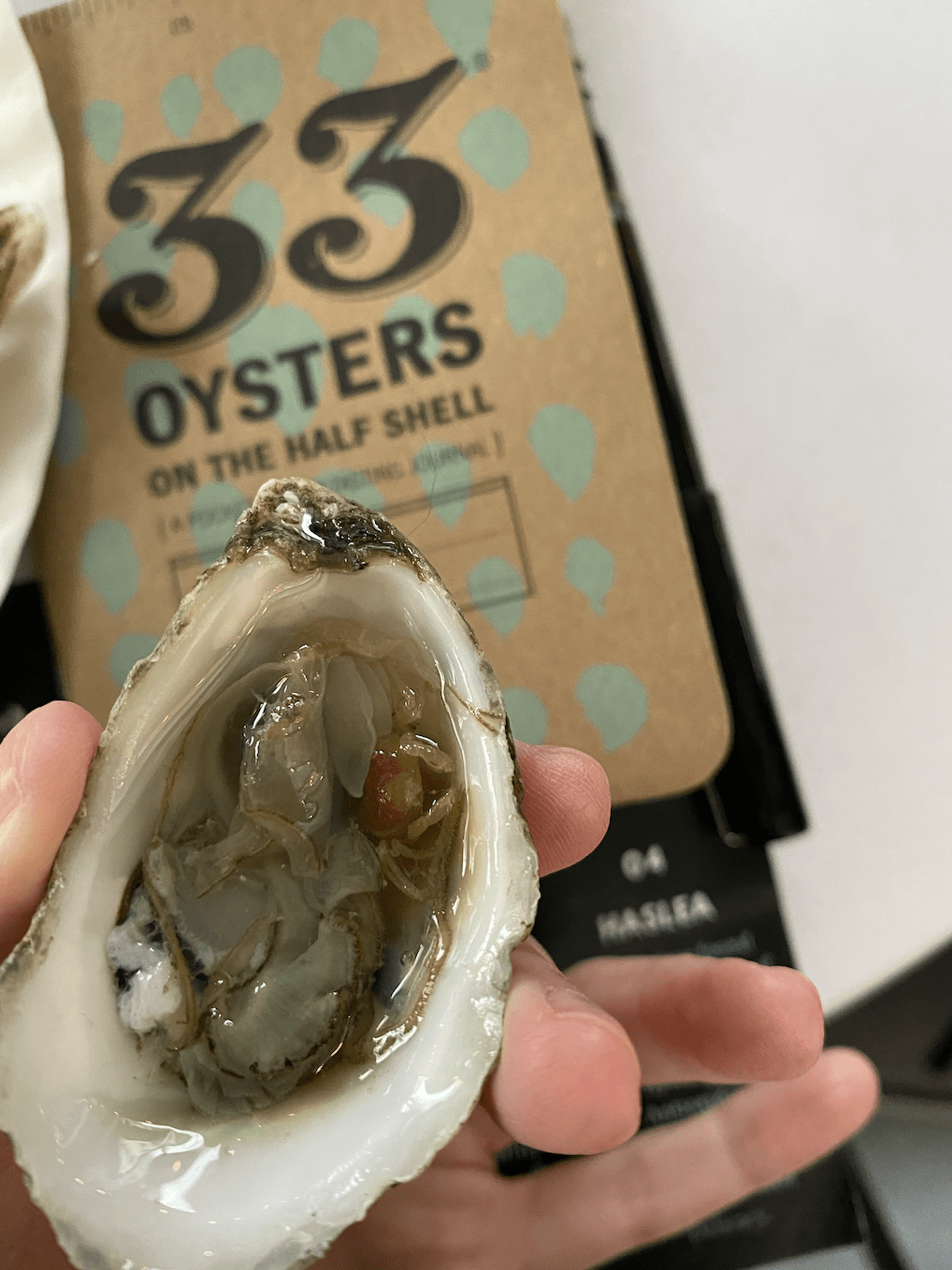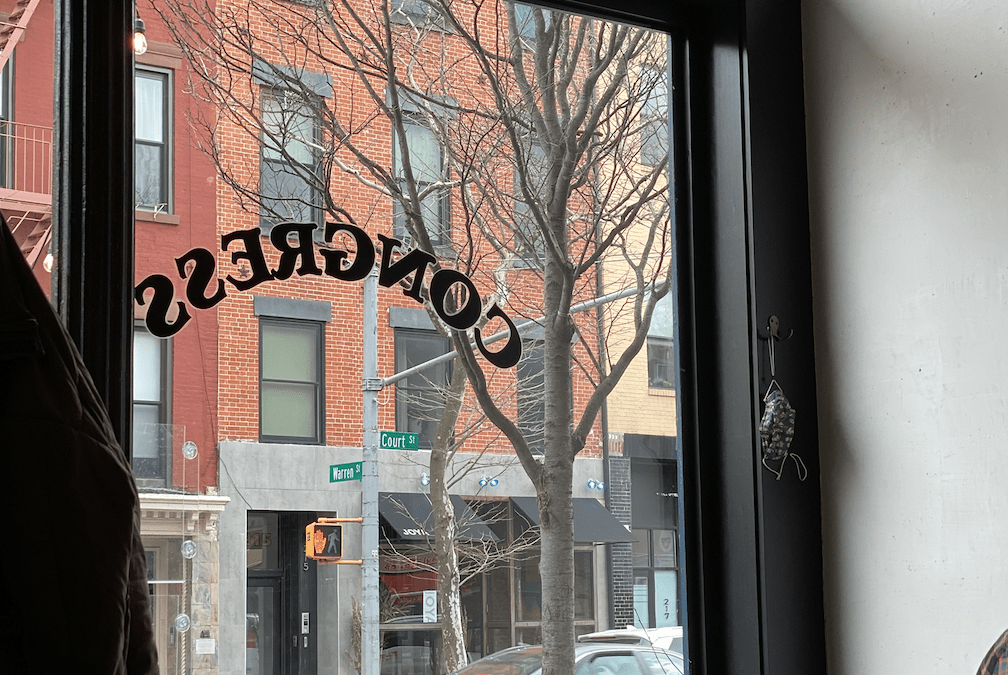April 7, 2022
This blog post was written by Caroline O’Kane.
It was a cool and windy Wednesday evening in the Cobble Hill section of Brooklyn, where the staff of Congress Bar prepared for a NYC Oyster Lovers Club meeting on the heated patio. The event marks a bi-monthly, in-person meeting of members and new participants, previously held on Zoom during the pandemic. As we brace for a vaccinated and boosted warmer season of our “new normal”, these are the events I crave.
Julie Qiu, self-proclaimed Oyster Sommelier, coordinates these tasting events through the following she has generated with her blog, In a Half Shell. The blog works to debunk oyster myths and misconceptions, present flavor profiles for diverse oyster varieties, introduce potential drink pairings, and highlight oyster bars that are doing something special.
She prides herself on introducing attendees to two varieties of oysters that are not readily available in New York City. As a local drop-off point for the CSA program (community shared agriculture- or, in this case, ‘aquaculture’), Congress Bar partnered with Julie as the host venue for her events. To participate in a CSA, consumers pay a fee at the start of the season for a weekly share of the harvest. In turn, they gain access to fresh, local produce at a cheaper cost than retail, in a way that directly supports the producer.
The two types that would be shucked for sampling were the ‘BeauSoleil’ variety from New Brunswick, Canada, and the ‘Divine Pines’ from Topsail Sound, North Carolina. While our documentary focuses on Northeast oyster production, this tasting provided a frame of reference for mollusks outside of our home region. The word that has emerged time and again to describe these oysters has been ‘salty’, but without an accompanying adjective like ‘balanced’, they are NOT kidding! These are SALTY!
From Maison BeauSoleil, these cups offer a sweet and nutty taste with high salinity. Equally remarkable in salinity, the ‘Divine Pine’ is unique in its green color, derived from the mollusk’s consumption of algae. The ‘Divine Pine’ is known as such during the winter months, while the same variety is dubbed the “Dukes of Topsail Sound” during the rest of the year. During the colder months, the water of Topsail Sound is clearer, allowing more sunlight to reach the algae, and leading to a bluer bloom there than anywhere else. As oysters naturally filter water, their digestion of the algae makes it safe for us to consume.
Green oysters have been popular in France for some time, but they were not an easy sell in North Carolina and required tactful marketing strategies. As someone who moved to NYC for her career in marketing, Julie spoke on the importance of showcasing the farms she has physically visited, and promoting them to the consumer directly.

Pea crab in oyster
“You might have the perfect oyster that has been meticulously cared for by its farmer, raised for roughly two years. It gets distributed to the restaurant, and maybe it wasn’t shucked properly, it is lacking in presentation, or there are shards of shell in the meat. These circumstances are beyond the control of the farmer, but can certainly damage their reputation and potentially turn off returning customers.”
When asked about her hopes for the future of oysters, she explained she hopes restaurants can elevate their standards for oyster service: “You might have the perfect oyster that has been meticulously cared for by its farmer, raised for roughly two years. It gets distributed to the restaurant, and maybe it wasn’t shucked properly, it is lacking in presentation, or there are shards of shell in the meat. These circumstances are beyond the control of the farmer, but can certainly damage their reputation and potentially turn off returning customers. We have seen oyster varieties grow on menus and in the restaurants that carry them. The demand is there.” The next step for success is protecting the names associated with these varieties. If restaurants work in tandem to elevate their oyster programs, it is better business for everyone.
Seeing your shucker in action is a reminder of the constant labor involved with bringing oysters from the tide to the table. More than that, when you are a witness to the occasional pea crab, you are reminded that not only do oysters improve the ocean homes of other species, but they actually are the homes for some species. Pea crabs are a small, soft-shell crab variety that are safe to consume and even considered a delicacy in some places. They are very cute, and one of our new friends at the event returned ours to the water.
Just about any crisp lager or white wine with minerality pairs well with an oyster on the half shell. Julie’s unique suggestion was to invest in a quality sake and try your oysters that way. But beyond the innumerable ways there are to enjoy oysters, there is an infinite number of ways oysters bring people of all kinds together for a shared experience. The remarkable journey of oysters does not end when they hit the table, nor once they’ve been enjoyed. They’re remarkable for a reason, and they keep us returning for more. Cheers!

